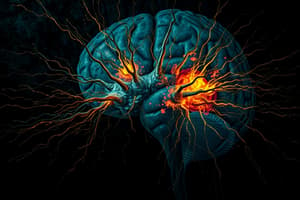Podcast
Questions and Answers
What type of generalized seizure involves both stiffening of muscles and rhythmic jerking of extremities?
What type of generalized seizure involves both stiffening of muscles and rhythmic jerking of extremities?
- Tonic seizure
- Myoclonic seizure
- Tonic-clonic seizure (correct)
- Atonic seizure
Which seizure type is characterized by brief jerking or stiffening of the extremities?
Which seizure type is characterized by brief jerking or stiffening of the extremities?
- Clonic seizure
- Focal seizure
- Myoclonic seizure (correct)
- Atonic seizure
What is a common manifestation during the clonic phase of a tonic-clonic seizure?
What is a common manifestation during the clonic phase of a tonic-clonic seizure?
- Rhythmic jerking of extremities (correct)
- Muscle tone loss
- Loss of consciousness
- Aura
Which of the following is NOT a characteristic of a tonic seizure?
Which of the following is NOT a characteristic of a tonic seizure?
What occurs during the postictal phase following a tonic-clonic seizure?
What occurs during the postictal phase following a tonic-clonic seizure?
Which type of seizure has a loss of consciousness without notable motor activity?
Which type of seizure has a loss of consciousness without notable motor activity?
What duration describes an absence seizure?
What duration describes an absence seizure?
Which of the following describes an atonic seizure?
Which of the following describes an atonic seizure?
Which of the following factors is a common trigger for seizures?
Which of the following factors is a common trigger for seizures?
Generalized seizures involve which of the following?
Generalized seizures involve which of the following?
What distinguishes complex partial seizures from simple partial seizures?
What distinguishes complex partial seizures from simple partial seizures?
Which statement accurately describes a simple partial seizure?
Which statement accurately describes a simple partial seizure?
What types of sensations might a person experience during a simple partial seizure?
What types of sensations might a person experience during a simple partial seizure?
Which of the following is NOT a feature of complex partial seizures?
Which of the following is NOT a feature of complex partial seizures?
During which type of partial seizure may a person exhibit behaviors they are not aware of?
During which type of partial seizure may a person exhibit behaviors they are not aware of?
What is the primary focus of nursing care during a seizure?
What is the primary focus of nursing care during a seizure?
Which action is appropriate after a seizure has occurred?
Which action is appropriate after a seizure has occurred?
What should be avoided during a seizure to prevent injury?
What should be avoided during a seizure to prevent injury?
What is the primary goal when administering antiepileptic drugs?
What is the primary goal when administering antiepileptic drugs?
Why is it essential to educate clients about taking antiepileptic medications consistently?
Why is it essential to educate clients about taking antiepileptic medications consistently?
What position should a client be placed in after a seizure?
What position should a client be placed in after a seizure?
What common side effect should clients be monitored for when on antiepileptic medications?
What common side effect should clients be monitored for when on antiepileptic medications?
Which factor can potentially trigger seizures in clients?
Which factor can potentially trigger seizures in clients?
What should be done regarding the monitoring of antiepileptic drug levels?
What should be done regarding the monitoring of antiepileptic drug levels?
What is a potential consequence of developing tolerance to antiseizure medications over time?
What is a potential consequence of developing tolerance to antiseizure medications over time?
What is the purpose of initiating a social services referral for a client with seizure activity?
What is the purpose of initiating a social services referral for a client with seizure activity?
What specific type of seizures is vagal nerve stimulation used to treat?
What specific type of seizures is vagal nerve stimulation used to treat?
What should clients avoid to prevent complications while using a vagal nerve stimulator?
What should clients avoid to prevent complications while using a vagal nerve stimulator?
Which statement is correct regarding responsive neurostimulation systems (RNS)?
Which statement is correct regarding responsive neurostimulation systems (RNS)?
What is a characteristic of laser interstitial thermal therapy (LiTT)?
What is a characteristic of laser interstitial thermal therapy (LiTT)?
Which procedure is typically done before conventional surgical procedures for seizures?
Which procedure is typically done before conventional surgical procedures for seizures?
What role does the disability office play for a school-age child with seizure activity?
What role does the disability office play for a school-age child with seizure activity?
What is a common misconception regarding seizure-related discrimination?
What is a common misconception regarding seizure-related discrimination?
What is the primary function of the vagal nerve stimulator device?
What is the primary function of the vagal nerve stimulator device?
Which of the following actions can clients with a vagal nerve stimulator take during a seizure?
Which of the following actions can clients with a vagal nerve stimulator take during a seizure?
What does the intracarotid amobarbital (Wada) test primarily assess?
What does the intracarotid amobarbital (Wada) test primarily assess?
What is the purpose of a partial corpus callosotomy?
What is the purpose of a partial corpus callosotomy?
What potential complication might arise from surgical procedures on the brain?
What potential complication might arise from surgical procedures on the brain?
Which nursing action is essential for a client with seizures?
Which nursing action is essential for a client with seizures?
What aspect of antiepileptic drug (AED) management is critical for clients?
What aspect of antiepileptic drug (AED) management is critical for clients?
Which is a potential limitation for individuals with a history of seizures regarding driving?
Which is a potential limitation for individuals with a history of seizures regarding driving?
How can an individual's seizures impact the effectiveness of oral contraceptives?
How can an individual's seizures impact the effectiveness of oral contraceptives?
What kind of testing can evaluate if visuospatial function is affected?
What kind of testing can evaluate if visuospatial function is affected?
In performing a brain procedure, which of these factors must be significant in decision-making?
In performing a brain procedure, which of these factors must be significant in decision-making?
What should clients with a history of seizures be educated about regarding their condition?
What should clients with a history of seizures be educated about regarding their condition?
What defines status epilepticus?
What defines status epilepticus?
Which is a complication of status epilepticus?
Which is a complication of status epilepticus?
Which nursing action is NOT a priority for managing status epilepticus?
Which nursing action is NOT a priority for managing status epilepticus?
What is one of the primary risk factors for Sudden Unexpected Death in Epilepsy (SUDEP)?
What is one of the primary risk factors for Sudden Unexpected Death in Epilepsy (SUDEP)?
Which nursing action is important for the prevention of SUDEP?
Which nursing action is important for the prevention of SUDEP?
What percentage of SUDEP cases occur during sleep?
What percentage of SUDEP cases occur during sleep?
Which of the following is a non-pharmacological intervention for managing seizure activity?
Which of the following is a non-pharmacological intervention for managing seizure activity?
Why is it important for clients to keep a journal of their seizure activity?
Why is it important for clients to keep a journal of their seizure activity?
Which of the following is NOT a potential consequence of status epilepticus?
Which of the following is NOT a potential consequence of status epilepticus?
What is a common emergency medication used in the treatment of status epilepticus?
What is a common emergency medication used in the treatment of status epilepticus?
Flashcards
Generalized Seizure
Generalized Seizure
A seizure involving both brain hemispheres.
Tonic-Clonic Seizure
Tonic-Clonic Seizure
A seizure with stiffening (tonic) and jerking (clonic) phases.
Tonic Seizure
Tonic Seizure
Seizure with stiffening of muscles & loss of consciousness.
Clonic Seizure
Clonic Seizure
Signup and view all the flashcards
Myoclonic Seizure
Myoclonic Seizure
Signup and view all the flashcards
Atonic/Akinetic Seizure
Atonic/Akinetic Seizure
Signup and view all the flashcards
Absence Seizure
Absence Seizure
Signup and view all the flashcards
Focal Seizure
Focal Seizure
Signup and view all the flashcards
Aura
Aura
Signup and view all the flashcards
Postictal Phase
Postictal Phase
Signup and view all the flashcards
Complex Partial Seizure
Complex Partial Seizure
Signup and view all the flashcards
Simple Partial Seizure
Simple Partial Seizure
Signup and view all the flashcards
Automatisms
Automatisms
Signup and view all the flashcards
Amnesia
Amnesia
Signup and view all the flashcards
Patient-centered care during a seizure
Patient-centered care during a seizure
Signup and view all the flashcards
Positioning a patient during a seizure
Positioning a patient during a seizure
Signup and view all the flashcards
What NOT to do during a seizure
What NOT to do during a seizure
Signup and view all the flashcards
Post-seizure care
Post-seizure care
Signup and view all the flashcards
Antiepileptic drugs (AEDs)
Antiepileptic drugs (AEDs)
Signup and view all the flashcards
Therapeutic levels of AEDs
Therapeutic levels of AEDs
Signup and view all the flashcards
Importance of consistent AED dosage
Importance of consistent AED dosage
Signup and view all the flashcards
Possible effects of long-term AED use
Possible effects of long-term AED use
Signup and view all the flashcards
Common adverse effects of AEDs
Common adverse effects of AEDs
Signup and view all the flashcards
Client education regarding AEDs
Client education regarding AEDs
Signup and view all the flashcards
Social Services Referral for Medication
Social Services Referral for Medication
Signup and view all the flashcards
Vocational Evaluation for Epilepsy
Vocational Evaluation for Epilepsy
Signup and view all the flashcards
IEP for School-Age Children with Epilepsy
IEP for School-Age Children with Epilepsy
Signup and view all the flashcards
Vagal Nerve Stimulation (VNS)
Vagal Nerve Stimulation (VNS)
Signup and view all the flashcards
VNS for Focal Seizures
VNS for Focal Seizures
Signup and view all the flashcards
Magnet Activation of VNS
Magnet Activation of VNS
Signup and view all the flashcards
Responsive Neurostimulation System (RNS)
Responsive Neurostimulation System (RNS)
Signup and view all the flashcards
Laser Interstitial Thermal Therapy (LiTT)
Laser Interstitial Thermal Therapy (LiTT)
Signup and view all the flashcards
Conventional Epilepsy Surgery
Conventional Epilepsy Surgery
Signup and view all the flashcards
EEG Monitoring Before Epilepsy Surgery
EEG Monitoring Before Epilepsy Surgery
Signup and view all the flashcards
Corpus Callosotomy
Corpus Callosotomy
Signup and view all the flashcards
Wada Test
Wada Test
Signup and view all the flashcards
Neuropsychological Testing
Neuropsychological Testing
Signup and view all the flashcards
Seizure Management Education
Seizure Management Education
Signup and view all the flashcards
AED Levels
AED Levels
Signup and view all the flashcards
Medication Interactions
Medication Interactions
Signup and view all the flashcards
Medical Identification Tag
Medical Identification Tag
Signup and view all the flashcards
Driving Laws for Seizure History
Driving Laws for Seizure History
Signup and view all the flashcards
Morbidity Risks of Corpus Callosotomy
Morbidity Risks of Corpus Callosotomy
Signup and view all the flashcards
AED Dosage Consistency
AED Dosage Consistency
Signup and view all the flashcards
Status epilepticus
Status epilepticus
Signup and view all the flashcards
Complications of status epilepticus
Complications of status epilepticus
Signup and view all the flashcards
Treatment for status epilepticus
Treatment for status epilepticus
Signup and view all the flashcards
Sudden Unexpected Death in Epilepsy (SUDEP)
Sudden Unexpected Death in Epilepsy (SUDEP)
Signup and view all the flashcards
Risk factors for SUDEP
Risk factors for SUDEP
Signup and view all the flashcards
Nursing actions to prevent SUDEP
Nursing actions to prevent SUDEP
Signup and view all the flashcards
Why is good sleep hygiene important for epilepsy patients?
Why is good sleep hygiene important for epilepsy patients?
Signup and view all the flashcards
What are seizure alert devices used for?
What are seizure alert devices used for?
Signup and view all the flashcards
How do you encourage seizure journal keeping?
How do you encourage seizure journal keeping?
Signup and view all the flashcards
What are some ways to avoid seizure triggers?
What are some ways to avoid seizure triggers?
Signup and view all the flashcards
Study Notes
Seizure Triggering Factors
- Increased physical activity
- Excessive stress
- Hyperventilation
- Overwhelming fatigue
- Acute alcohol ingestion
- Excessive caffeine intake
- Exposure to flashing lights
- Substances like cocaine, aerosols, and inhaled glue products
- Illness
Seizure Types: Generalized Seizures
- Involve both cerebral hemispheres
- Can begin with an aura (altered vision, smell, hearing, or feelings)
- Five types:
- Tonic-clonic:
- Tonic phase (muscle stiffening, loss of consciousness, few seconds)
- Clonic phase (rhythmic jerking, 1-2 minutes)
- Breathing stops/irregular, cyanosis possible, cheek/tongue biting, incontinence
- Postictal phase (confusion, sleepiness)
- Tonic:
- Only tonic phase experienced
- Sudden loss of consciousness, increased muscle tone, autonomic manifestations (arrhythmia, apnea, vomiting, incontinence, salivation)
- Generally lasts less than 30 seconds (some sources say several minutes)
- Clonic:
- Only clonic phase experienced (rhythmic jerking)
- Muscles contract and relax
- Can last several minutes
- Myoclonic:
- Brief jerking or stiffening of extremities (symmetrical or asymmetrical)
- Lasts seconds
- Atonic/Akinetic:
- Loss of muscle tone for a few seconds
- Often results in falling
- Followed by confusion
- Absence:
- Loss of consciousness (10-30 seconds)
- No or mild symmetrical activity (e.g., blinking.)
- Can occur hundreds of times daily
- Rare in adults, usually stops during adolescence
- Tonic-clonic:
Seizure Types: Focal Seizures
- Involve only one cerebral hemisphere
- Two types:
- Partial/focal/local: (specific information not provided)
Studying That Suits You
Use AI to generate personalized quizzes and flashcards to suit your learning preferences.





